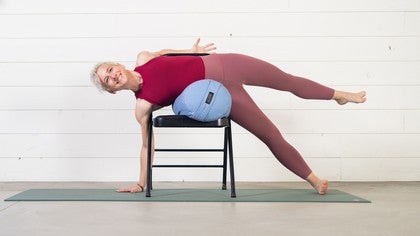
15 Basic Tips for Successful Online Yoga Teaching
There are as many ways to practice yoga as people practicing. Each teacher brings their own harmonic to the chorus. The more teachers sharing widely, the faster we can collectively grock that each of us has our own access to the source from where these teachings come. It’s so fun to listen to each other’s songs and let it help us tune into our own.
I have been filming yoga classes and workshops and putting them online since the late 90s. But filming and uploading is a way different trip than the freefall of broadcasting live. It takes the art of spiritual entertainment to a new level. Here are 15 basic suggestions on how to help you ground and prepare for the inevitable rush and ensure you are set up to share the teachings of yoga clearly.
1. Make sure your technology works
Before you go live for real, do some dry runs with your friends to make sure they can see and hear you through your chosen platform. Go through the steps several times and even make yourself a detailed checklist so that your mind is free and relaxed. Each and every time you upgrade your software or hardware, repeat the testing process. A simple update anywhere in your broadcasting setup can change everything.2. Help your students know how their technology works
If you are lucky enough to be teaching more intimate classes, identify students who might be new to the method through which you are sharing and reach out directly. Working 1:1 in this way will help you know how to write out login and access instructions more clearly and concisely for a wider audience.3. Invest in a strong internet connection
You can bolster your internet connection through your provider and with boosters. You might be teaching from home for a while, so make the investment. It's unlikely that you are going to become an expert in video compression and upload speeds, so choose the best plan you can afford with a minimum upload speed of 3Mbps, but note that 13Mbps is recommended for higher quality video. And when you are teaching live, do your best to ensure none of your other housemates are using the internet at the same time.4. Invest in quality audio equipment
Yes, the quality of your camera matters. The quality of your sound matters so much more. Airpods are a pretty great solution, but have mixed reliability and fall out easily. We suggest a simple low cost mic pack with headset that you can hook up to your laptop or phone. Read more tips on best production practices.5. Prepare like you used to
Whatever you used to do before teaching at your local studio or gym, do those same things. Shower, choose your yoga costume, practice beforehand, and make a plan. Promote the class, ask your friends to come, ask for internal guidance, and make yourself available to the teachings.6. Show up early
The rockstar arrival at the last minute does not work well for Live. There are so many small details to attend to and get right, that you do everyone (especially yourself) a great service by showing up and being available to whatever arises before class starts.7. Diffuse the pressure
Every yoga teacher knows that mild grumpy pants attitude before teaching a class. It’s a feeling of being squeezed into the moment and a strange lack of availability for anything else. But instead of showing up to class where physical touch helps diffuse our self centered performance anxiety and open to the moment, there is a strange vata-disorienting void. A few audible long sighs with an open mouth can help you ground and open up to the excitement and mystery of the situation.8. Connect with who shows up
Even though you are staring at the camera of your laptop, tablet, or phone, your yoga friends are with you, co-creating the moment. The harmonic is less tangible, you will not hear them laugh or groan at your jokes, nor will you be able to see if someone is struggling. Calling out to your virtual community by name (or location if safer) will help you tune into and respond to guidance of the group who has gathered to practice together.9. Connect with the camera
It can seem weird at first, but making eye contact with the camera will help your at home audience feel attended to. Your class is looking at you from the point of the view of the camera, so turn, twist, and adjust so that your students behind the camera lens can see what you are doing. For example, if you are doing something tricky with your hands behind your back - like bind, wrap, or press - turn so we can see what you are doing!10. Start and end on time
It may seem like people have more time for home practice, but not really, especially if work has moved home, home school is still in session, and elderly parents are being cared for. Honoring the agreement of time is kind, respectable, and creates a safe environment.11. Rely on friends for feedback
Oprah Winfrey used to recall that no matter the status of her guests, everyone would ask for reassurance after interviewing on her show. “Did I do okay?” or “Was that good?” were the common probes. Over the last 5 years in Yoga Anytime’s filming studio, after every episode, every single teacher needed to know how it went. Now that we’ve gone Live, nothing has changed. As humans, we need to know how we’re doing, and we need others to tell us. So for every class you teach, have a least one good friend attend who will reassure you at the end that class was great (or at least good enough) and thank you. It will help ensure you keep teaching.12. Watch live programming for inspiration
Hulu has all the old SNL skits available. Ralph Nadar’s 1976, Season 2, Episode 12 is hilarious. Watch how the current late night talk show hosts like Jimmy Fallon, Stephen Colbert, Conan, and Jimmy Kimmel have adapted to broadcasting from home. There is nothing loose or unscripted going on in these shows. Live broadcast requires a tighter, more focused, more attuned plan.13. Promote your classes with enthusiasm
This is most yoga teachers' least favorite part of the gig. There is a strange mindset that imagines that "If I teach, they will come." Or worse, "It's tacky to promote your classes." Neither of these are true. Help us know when you're teaching, and make it easy for us to find you. Resist the temptation to add verbiage like "so grateful" and "so blessed" to try to minimize the commercial feel. Being committed and consistent with your schedule is essential to developing a virtual following. Be super extra clear about your timezone. Invite individual people directly.14. Promote others
When it feels like everyone is going Live, it can also feel competitive. Seek opportunities to collaborate with your fellow yoga teachers, promote each other, show up for each other’s classes and celebrate this new landscape together. Maybe host some conversations and discussions with other teachers and share stories from the field, so your field gets bigger.15. Be you
This is that age old advice that keeps coming back around, and the punchline is that you don’t really have a choice. There used to be a translation of a sloka from the Bhagavad Gita hanging in the halls of Kripalu that read, “Yoga is tolerating the consequences of being yourself.” Pretty sure it was an interpretation of Chapter 18, Verse 47: “Better to do your own dharma badly than someone else’s well,” which essentially gives cosmic permission to relax and enjoy the trip you’re on.Listen to this interview conducted by Shannon Crow a few years back about making good online videos. And be sure to tune in to Yoga Anytime Live for community and inspiration!
Comments
You need to be a subscriber to post a comment.
Please Log In or Create an Account to start your free trial.













